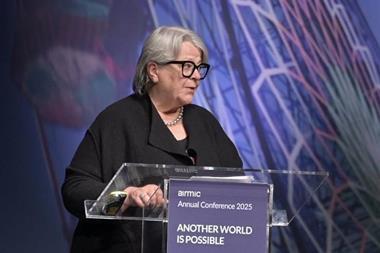Some large captives are preparing to redomicile to the UK, Airmic has confirmed, as momentum builds behind a new domestic regime.
After yesterday announcing that Airmic is “bullish” on plans for a new captive regime, CEO Julia Graham has now revealed that some captives are preparing to relocate to the UK under the new framework.
Speaking during the closing panel of the Airmic conference, Graham said a small number of firms had already informed Airmic of their intention to redomicile once the regulatory regime is established. She added that this is not just a theoretical possibility, noting that “a small number of large captives may well relocate to London… They’ve told us that they will.”

However, the risk association continues to emphasise the benefits of the proposed regime as a way to support new captive formation and broaden market access. Graham was clear that such moves should not come at the expense of established domiciles. “We do not encourage an avalanche of transfers,” she said.
She also emphasised the national scope of the initiative, stating, “This is a UK initiative, not a London initiative. It is a UK strength that we’re looking for, not just the city.”
Many of the high-profile insurance panel echoed that view, emphasising that the regime should serve businesses across the country. With risk expertise and insurance ecosystems already present in regions including the North West, Scotland and Northern Ireland, a UK-based framework could stimulate growth beyond the capital.
“Wouldn’t it be cool to see some of these entities cropping up around the UK and using the ecosystem we have?” said Marsh McLennan UK CEO Chris Lay.
Graham reinforced the point, highlighting the strength of regional talent and Airmic’s commitment to ensuring the regime supports the wider UK market, not just established financial centres.
A growing need for alternative risk financing
Captives, once considered the domain of large multinationals, are increasingly being viewed as a viable option for a wider range of businesses. In that context, an accessible, proportionate onshore regime could offer new flexibility for UK-based firms navigating volatile risk landscapes.
The strongest potential impact may lie not with redomiciliation, but in expanding access. Lay commented that the regime could unlock growth among firms that currently see offshore options as too complex or remote. “The mid-market are less likely to travel to offshore jurisdictions to deal with the sort of legality and tax issues that that imposes,” he said.
He added that Marsh has supported the creation of nearly 400 new captives globally over the past three to four years, with much of that growth coming from mid-sized firms. A UK-based regime, he argued, would give them a viable, proportionate alternative
Tom Richardson, group insurance manager at ABF, agreed that a domestic option could lower the threshold for participation, adding that captives are already proving valuable amongst this group for piloting cover for complex or evolving risks, including where traditional insurance is constrained by exclusions or pricing.
Airmic’s member data backs this up. A recent survey showed that 75% of organisations without a captive are now actively exploring one. Brokers, meanwhile, are developing captive cell structures that offer simpler entry points, especially for organisations aiming to test coverage for areas like cyber, employee benefits or environmental exposures.
Supporting stronger risk governance
Beyond accessibility, panellists emphasised the strategic value of captives. Properly implemented, they can drive improvements in risk governance, data quality, and decision-making.
Nina Arquint, CEO UK & Ireland at Swiss Re Corporate Solutions, noted that captives are most effective when embedded within the business’s broader enterprise risk management strategy. “You can only, in my view, really run a captive in a meaningful way if you have a centralised approach to risk management and if you take quite a strategic view on it,” she said.
Several speakers also highlighted captives’ role in fostering better risk behaviour. David Haas, global head of casualty at CNA Hardy, said that companies taking meaningful retention often show stronger loss prevention and control, ultimately benefiting the wider insurance market through more focused underwriting partnerships.
Building out the UK framework
There is still no formal confirmation from HM Treasury on the captive regime. However, Lay described the signs as “very encouraging. Yesterday, Graham suggested that an announcement may be timed to coincide with the Chancellor’s Mansion House speech later this summer.
In preparation, Airmic is forming working groups to help shape how the regime might operate. Launching in July, these groups will bring together Airmic members and other industry participants.
For corporate risk teams, the development of a UK captive regime represents both an opportunity and a challenge. Now is a good time to assess whether a captive could support business objectives by identifying uninsurable risks or gaps in cover, mapping out loss data and actuarial inputs, and working with finance to understand the implications of capital allocation and retained risk on the balance sheet.
Equally important is engaging internal stakeholders. Captives require alignment between finance, legal, risk and operational teams. Senior leadership will need to understand the purpose and value of a captive, particularly if it is to play a strategic role.
Those with existing offshore captives may also wish to review whether UK activity could complement or even replace, current arrangements, for example, by testing specific risks or expanding into new lines.
Captives are not a one-size-fits-all solution. But as Graham reminded delegates, the UK regime is no longer just an ambition. It’s taking shape - and for many risk teams, this could be the moment to act.
BLOG: Airmic Conference 2025 Daily News Summary

Stay tuned - live reporting from the Airmic Conference this week - all in one place
- 1
 Currently
reading
Currently
reading
Captives will relocate to the UK, confirms Airmic CEO
- 3
- 4
- 5
- 6
- 7
- 8
- 9
- 10
- 11
- 12
- 13
- 14
- 15
- 16













































No comments yet